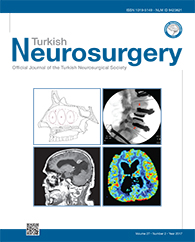2Antalya Education and Research Hospital, Neurosurgery Clinic, Antalya, Turkey
3Hacettepe University, Institute of Neurological Sciences and Psychiatry, Department of Neurosurgery, Ankara, Turkey
4Hacettepe University, School of Medicine, Department of Radiology, Ankara, Turkey
5Hacettepe University, School of Medicine, Department of Pathology, Ankara, Turkey DOI : 10.5137/1019-5149.JTN.15780-15.1 AIM: Pediatric glioblastoma (GBM) is still a topic obscurity. The aim of this study was to explore clinical, radiological and pathological features, and prognostic factors affecting the outcomes.
MATERIAL and METHODS: We retrospectively reviewed our database for prognostic factors for 42 consecutive pediatric patients with histologically proven GBM treated in our hospital.
RESULTS: The study reached at 20 boys and 22 girls, with a mean age of 10.2 years. Almost all patients (97.6%) had supratentorial tumors; lobar/hemispheric (68.3%), thalamic (26.8%) and suprasellar-hypothalamic region (4.8%). Total of 11/42 children had seeding metastases (mean 11.5 months) either preoperatively or postoperatively. Gross total resection (GTR) was achieved in 13 patients (30.9%) in the first surgery. Perioperative mortality and morbidity rates were 4.7% and 19%, respectively. Patients were followed for an average of 18.1 months. The median progression-free and overall survivals were 7.0 (95% CI: 5.9-8.0) and 11.0 (95% CI: 8.9-13.1) months, respectively. 1-year, 2-year and 5-year progression-free survival and overall survivals were 30.9% vs. 50.0%, 11.9% vs. 19.0%, 4.8% vs. 9.5%; respectively.
CONCLUSION: Gross total resection should be safely attempted in pediatric GBM. In addition, a thorough and frequent radiological evaluation of the entire neuraxis for seeding metastases is recommended both at diagnosis and follow-ups.
Keywords : Children, Glioblastoma, Management, Metastasis, Prognosis, Surgery




